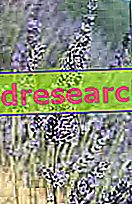Lavandula officinalis Chaix
Lavandula hybrida Rev.
Fam. Lamiaceae (Labiatae)
Br. Lavande and Lavandin
Ing. Lavender and Lavendin
Ted. Lavendel
Sp. Espliego
Description
Genus of suffrutticose plants that includes 28 species of temperate zones, of which the main ones are: L. angustifolia, L. vera, L. officinalis, L. stoechas, L. spica, L. latifolia and interspecific hybrids, which take the name of sinks.
Lavender is about 50 cm high, very branched with erect quadrangular flowering stems, small and linear leaves, initially covered with down, later hairless.
The violet-blue flowers are small and gathered in terminal inflorescences (spicastri) that bloom in June-July, giving off a characteristic and intense fragrance.
The fruit is an achene in lavender, while it is absent in the sink because the plant is a sterile hybrid. Hybrids can be recognized by true lavender due to the presence of secondary inflorescences inserted in the axilla of the main stem and to the wider axillary bract of the flowers.

Areal
There are various species of spontaneous lavender which have different distribution areas even though they all lead back to the Mediterranean region. The species present at altitudes above 500-600 m asl It is the L.officinalis typical of dry environments and calcareous soils. It is 50 to 80 cm high and lives spontaneously or naturalized in different mountain or submontane areas. The species present at altitudes below 500m is L. spica, 40-50 cm high, very sensitive to cold and strong camphorated odor, L. stoechas, also sensitive to the cold, adapts well to sandy soils and dry environments.
In general, plants of the genus Lavandula prefer dry, calcareous and deep soils; they badly tolerate acid soils while adapting well to alkaline ones.
They are often used against the erosion of less stable sloping land.
The hybrids are the object of greater cultivation for the yield of essence and for being plants with greater vegetative development and stems of the inflorescences of considerable length. Currently the sink ( L.hybrida Rev.) is mainly cultivated, which is a natural and sterile hybrid of L. officinalis x L. spica.
France, Spain, the former Soviet Union, Bulgaria, Hungary and England are the main cultivation countries. The cultivation can last 6 or 10 years respectively for the lavender and the sink. The plant is preferably made from cuttings for both because it is difficult to find genetically homogeneous seeds (for fertile lavender) and because seed plants are less productive.
The cuttings, generally herbaceous, 12-15 cm long, are taken in autumn or spring from a young plant of 2 years and are placed in the nursery for rooting, facilitated by the use of hormonal substances. After 1 year the transplant is performed in rows spaced 1.5-2 m (about one plant / m2). Nitrogen-phosphorus and potassium fertilizers (50-60 kg / ha) at the plant and 60-70 kg / ha are subsequently to be carried out in spring
There are various fungi, responsible for root and collar rot, a virus, a nematode, two diptera, which cause necrosis of stems, beetles and moths. Septoria, a fungus that attacks young shoots, can cause serious damage, so it is necessary to check it with 3 applications of Bordeaux mixture or other products per year.
It is good to remember that lavender is a melliferous plant, so any treatments must be compatible with the needs of bees.
Weeds can be fought with weeds, but light, to avoid damaging the roots which are quite superficial
Collection and yields
Harvesting begins on 2-year plants with increasing yields over the next 5-6 years; we operate with mowing machines that link the inflorescences and a little herbaceous stem, leaving the woody parts of the plant intactThe distillation product must not contain leaves because they give the essential oil a sour taste that is not very welcome.
The optimal time coincides with the beginning of the fading.
The maximum yield in inflorescences is 5-7 t / ha for lavender, 12-15 for the sink.
The quantity and quality of lavender essence is influenced by various environmental and cultivation factors:
1) the altitude causes a decrease in quantity, but an improvement in quality: it increases the content of linalyl acetate and decreases the camphor;
2) Fertilization with K increases the presence of camphor, while P and N decrease it. If it is exceeded with N and P the essence content is reduced;
3) hot winds or rain during flowering reduce yield
4) the cultivars used are important.
Drug
It is given by the inflorescences, from which a very precious essence is extracted by steam current distillation, often performed in the place of collection. The flowers for herbal medicine are collected at the beginning of flowering, while for the cosmetic and perfume industries in the period of maximum flowering; they are then dried and distilled. They contain an essential oil with linalyl acetate (30-55%), linalool, cineol and camphor
uses
In phytotherapy, lavender is used for its antiseptic, vasodilatory, antineuralgic properties in muscular and arthritic pains, sedatives in mild states of insomnia or states of agitation.
In cosmetics : it serves essentially to make perfumes.
Other uses : it is a melliferous plant from which precious honey is obtained, considered suitable for treating bronchopulmonary diseases, such as rheumatic diseases and asthma.



